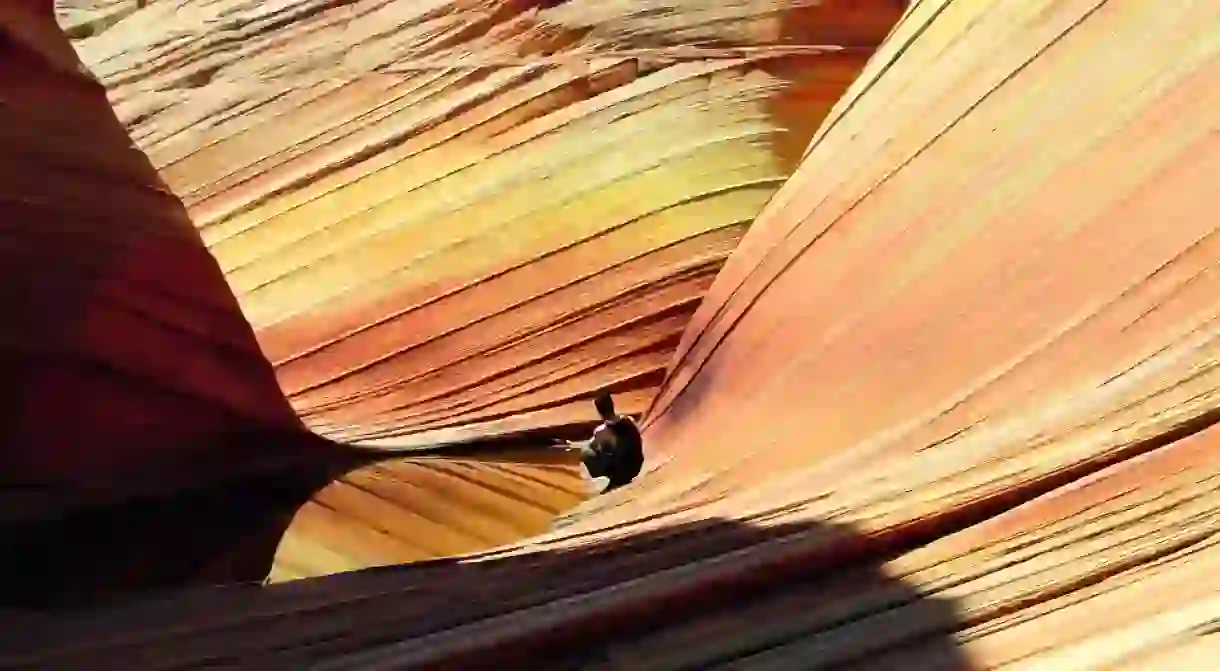Walk on Mars at The Wave in Arizona

A dream destination for hikers and photographers, the Wave – located in the wilderness of Arizona – transports you to another world.
Protected by strict visiting regulations, those lucky enough to win a pass to explore this challenging and fragile landscape are treated to scenes of striking natural phenomena, cast in shades of brightest vermillion.

Ever wondered what life on Mars is like? Here, it’s easy to imagine that you’re hiking the Red Planet rather than exploring anything on Earth.
Out of this world
Arizona’s unforgettable scenery is dominated by Navajo Sandstone – a red-hued rock that varies widely in color to reflect its history of weathering.
Beautiful and bizarre, the rock formations that furnish Arizona’s landscape are unrivaled and completely unique to the area. But the forms and colors at Coyote Buttes North, where you’ll find the magnificent Wave, are arguably the most incredible.
Dinosaur tracks that have been discovered nearby date the Wave back to the Early Jurassic era, making these formations a staggering 2 to 5 million years old and giving gravitas to the otherworldly atmosphere.
Great tide of rock
Wind, water and debris (not to mention compression – allegedly from herds of dinosaurs) has molded the original sand dunes into smooth rock over the millennia.
Undulating ridges or mini ‘waves’ formed over time have combined to create vast swathes of rippling sandstone – giving the illusion that you’re caught up in a great tide of red rock.
Resembling the natural swell of ocean waves, the colossal rock formations of the Wave are the reason this place is widely regarded as one of the most spectacular photographic destinations in the world.
Hiking to the Wave
Probably the most surreal hiking experience on the planet, there’s plenty to see before you even reach the Wave, as scenery along the route is wild and rugged.
Visitors should prepare for a strenuous walk. Locating the spot is challenging, as is the unrelenting desert heat, so for amateur ramblers hiring a guide is highly recommended to get the most out of your experience.
There are purposefully few trail markers to help you on your way, so a map and compass are essential gear. Often natural landmarks are the clearest indicator that you’re heading in the right direction, and those without much knowledge or experience will inevitably take a few wrong turns.
A guide will save you time, while also pointing out interesting sights and providing fascinating information – you really don’t want to miss a thing.
How to visit and what is involved
Only a handful of people are permitted to hike the Wave per day – an action introduced by the Bureau of Land Management that maintains the area to control visitor numbers. This conservation measure is designed to limit damage from footfall and preserve the formations for future generations.
A lottery system determines entry passes for 20 people daily, with 10 passes allocated to those who have entered the lottery online in advance and 10 more released each day for those who turn up to try their luck.
It can take years to win a pass, but determination – or pure luck – will hopefully pay off, and oh boy is it worth the wait.
Safety and advice
As with nearby Antelope Canyon, flash flooding is a serious issue here. Rainwater cannot be absorbed by the rock, so the smallest amount of rain causes it to pool at an alarming rate and fill the buttes. Be mindful of these risks and check forecasts regularly.
Free orientation sessions run by the BLM give you a little bit of background and explain the crazy geology. Definitely try to catch one of these before embarking on your adventure, especially if you’re planning to hike without a guide. Without crucial info, many run the risk of arriving underprepared.
Finally, take water and lots of it! This is a desert environment and you will spend hours traversing rock and sand dunes, exposed to the intensely hot sun. At least three liters of water is recommended per person, and don’t forget all the usual sun protection.













